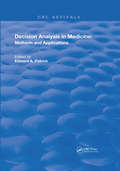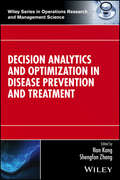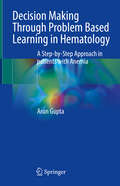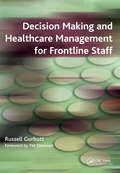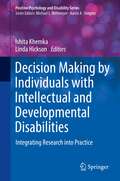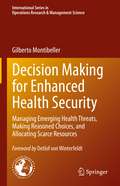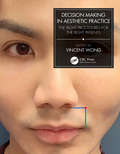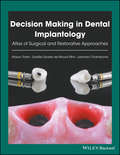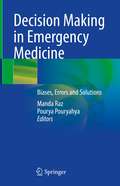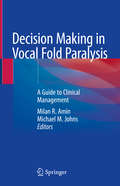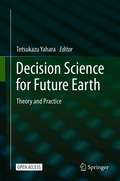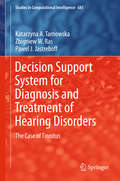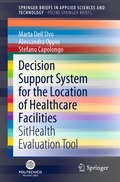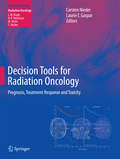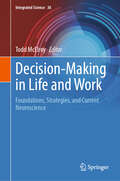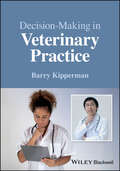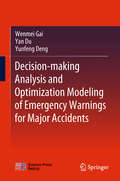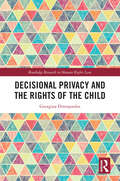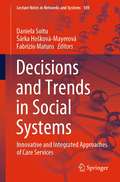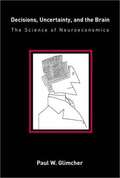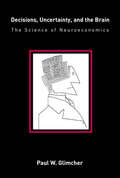- Table View
- List View
Decision Analysis Applied to the Field of Environmental Health (Professional Practice in Earth Sciences)
by Dilber Uzun Ozsahin Berna Uzun James LaMoreaux Tamer SanlidagThis book provides students and researchers with a resource that includes the current application of the multi-criteria decision theory in a variety of fields, including the environment, health care, engineering, and architecture. There are many critical parameters (criteria) that can directly or indirectly affect the consequences of various decisions. The application of the multi-criteria decision theory focusses mainly on the use of computational methods which include multiple criteria and orders of preference for the evaluation and the selection of the best option among many alternatives based on the desired outcome. The theory of multi-criteria decision making (MCDM) is an approach that can be extremely useful for students, managers, engineers of manufacturing companies, etc.
Decision Analysis in Medicine: Methods and Applications (Routledge Revivals #83)
by Edward A. PatrickFirst Published in 1979, this book offers a full, comprehensive guide to making the right decisions in diagnoses and treatment in medicine. Carefully compiled and filled with a vast repertoire of notes, diagrams, and references this book serves as a useful reference for students of medicine, and other practitioners in their respective fields.
Decision Analytics and Optimization in Disease Prevention and Treatment
by Nan Kong Shengfan ZhangA systematic review of the most current decision models and techniques for disease prevention and treatment Decision Analytics and Optimization in Disease Prevention and Treatment offers a comprehensive resource of the most current decision models and techniques for disease prevention and treatment. With contributions from leading experts in the field, this important resource presents information on the optimization of chronic disease prevention, infectious disease control and prevention, and disease treatment and treatment technology. Designed to be accessible, in each chapter the text presents one decision problem with the related methodology to showcase the vast applicability of operations research tools and techniques in advancing medical decision making. This vital resource features the most recent and effective approaches to the quickly growing field of healthcare decision analytics, which involves cost-effectiveness analysis, stochastic modeling, and computer simulation. Throughout the book, the contributors discuss clinical applications of modeling and optimization techniques to assist medical decision making within complex environments. Accessible and authoritative, Decision Analytics and Optimization in Disease Prevention and Treatment: Presents summaries of the state-of-the-art research that has successfully utilized both decision analytics and optimization tools within healthcare operations research Highlights the optimization of chronic disease prevention, infectious disease control and prevention, and disease treatment and treatment technology Includes contributions by well-known experts from operations researchers to clinical researchers, and from data scientists to public health administrators Offers clarification on common misunderstandings and misnomers while shedding light on new approaches in this growing area Designed for use by academics, practitioners, and researchers, Decision Analytics and Optimization in Disease Prevention and Treatment offers a comprehensive resource for accessing the power of decision analytics and optimization tools within healthcare operations research.
Decision Making Through Problem Based Learning in Hematology: A Step-by-Step Approach in patients with Anemia
by Arun GuptaIn this era of teaching through problem-based learning, this unique book guides approaching patients with anemia through a step-by-step analysis of test results. It explains the rationale for requesting appropriate tests and analyzing them systematically and correlates each answer to the disease-based entity on the latest evidence. The target audience is undergraduate medical students during hematopathology training and the introductory phase in clinical Medicine and Hematology, postgraduate residents in Hematology and Medicine, and undergraduate and postgraduate Allied Health students. It provides a quick reference source for practitioners and teachers in medical and paramedical institutions. Question-answer format for quick review before exams. Hundreds of visual illustrations with microscopic images and tables.Quick reference for students in wards and clinics.
Decision Making and Healthcare Management for Frontline Staff: v. 2, Diagnosis (Radcliffe Ser.)
by Russell Gurbutt Sarah CharlesworthDo you want to be a part of a service that puts service users' needs first? Do you want to understand the complexity of workplaces that can seem to stand in the way of achieving this? Do you want to develop your decision-making skills to help you make realistic, relevant decisions that put the service user first? Do you want to develop a strategic perspective whilst still being able to attend to the detail of service delivery? If the answer to these questions is 'yes', read this book. To be actively involved in decisions - and to avoid becoming passive spectators to decisions imposed from outside - service delivery staff need strong decision-making skills and strategic awareness. Decision Making and Healthcare Management for Frontline Staff helps provide the thinking space needed by service providers to ensure that the service user's experience remains the core focus and purpose. It leads readers through a series of reference points to help them reflect upon and understand their own clinical situation, the factors that shape decisions made within it, and how they can actively engage with that process. The book will be essential reading for frontline healthcare staff and managers in all specialties who wish to understand factors in health service delivery beyond their own immediate professional interests and engage actively with them to shape decisions. It also provides educators with a practical framework of six learning units around which healthcare management teaching and learning modules can be designed, and discussions and reflection can be held. This is not just another book. Russell Gurbutt has managed in this short book to look at health service management from a multitude of perspectives in an original and creative way. This is not a stuffy text book, but is written in a very personal style to the reader. I recommend this book to all health professionals, whether at the beginning of their career or those who need a fresh insight into their own managerial position, as well as educators who may want to use the coffee break exercises with their students. - From the Foreword by Pat Donovan
Decision Making by Individuals with Intellectual and Developmental Disabilities: Integrating Research into Practice (Positive Psychology and Disability Series)
by Ishita Khemka Linda HicksonThis book examines theoretical considerations in the study of decision making as well as practical applications in social interpersonal domains for adolescents and adults with intellectual and developmental disabilities (IDD). It provides a history of the study of decision making in individuals with IDD and examines emerging views on decision making from a positive psychology perspective. The book explores the role of decision making in self-determination as well as offers global perspectives on the rights and responsibilities of individuals with IDD to engage in independent decision making. It outlines a framework for the study of decision making in individuals with IDD, reviews research that addresses the role of culturally diverse influences on individual decision making, and examines likely consequences of the etiological bases of disability on decision-making profiles. Key areas of coverage include: · Critical role of basic processes of cognition, motivation and self-beliefs, affect and emotion, and various styles of decision making. · Applications of decision-making skills within family and community contexts, in personal and social relationships, during transition to adulthood and more independent lifestyles, and in successful community living. · Self-protective decision making by individuals in situations of abuse as well as in resisting peer victimization and bullying. · Decision-making parameters for enabling maximum participation in self-decision making, through shared and supported decision making in contexts such as health care, aging, and end-of-life decisions. · Research-based interventions to improve effective decision making in individuals with IDD.Decision Making by Individuals with Intellectual and Developmental Disabilities is a must-have reference for researchers, professors, and graduate students as well as clinicians and other professionals in the fields of developmental and positive psychology, rehabilitation, social work, special education, occupational, speech and language therapy, public health, and healthcare policy.
Decision Making for Enhanced Health Security: Managing Emerging Health Threats, Making Reasoned Choices, and Allocating Scarce Resources (International Series in Operations Research & Management Science #328)
by Gilberto MontibellerHealth threats pose significant dangers to humankind and form a major source of human suffering and sorrow. Responsible leadership and reasoned decision making can significantly improve the arenas that are affected by health threats, through establishing a better allocation of very scarce resources for building health capabilities and for increasing health preparedness, responsiveness and resilience.This book examines how public health leaders can use the cutting-edge research from Decision Sciences to better manage emerging and re-emerging health threats, with a focus on enhancing health security. While these decisions must be informed by the best available evidence, they must also address competing priorities and key uncertainties and must mitigate critical risks, albeit in a cost-effective manner which seeks to maximize societal value.This is a book about how decisions on health security can be improved, both in terms of the content that is utilized in a health decision analysis and the decision processes that are employed in reaching a decision. This decision-focused perspective can help public health leaders and public health experts to increase the health preparedness of health systems, the task of which involves improving health capabilities, increasing the robustness of health systems against health threats, as well as strengthening health resilience and the responsiveness of these systems against disease outbreaks.
Decision Making in Aesthetic Practice: The Right Procedures for the Right Patients
by Vincent WongDecision Making in Aesthetic PracticeThe Right Procedures for the Right Patients Edited by Vincent Wong, BSc, MBChB, Vindoc Aesthetics, London, UKHealthcare professionals in Aesthetic Practice are often faced with a presenting complaint that may seem straightforward to treat but lends itself to more than one treatment option. To achieve and deliver the best natural-looking results, certain basic points about the face must be respected; there must be a good understanding of the specific root cause of each patient’s complaint; and that knowledge must be communicated effectively with the patient. The aim of this book is to help guide a healthcare professional in selecting the best and most appropriate options for any patient. Contents: The Cosmetic Consultation * The Skin * The Forehead * The Periorbital Region * The Nose * The Cheeks* The Perioral Region * The Chin * The Jawline and Neck* The Scalp * Balancing Non-Surgical and Surgical Clinical Approaches
Decision Making in Dental Implantology: Atlas of Surgical and Restorative Approaches
by Leandro Chambrone Mauro Tosta Gastão Soares de Moura FilhoDecision Making in Dental Implantology: Atlas of Surgical and Restorative Approaches offers an image-based resource to both the surgical and restorative aspects of implant therapy, presenting more than 2,000 color images with an innovative case-by-case approach. Takes a highly pictorial approach to all aspects of implant dentistry Discusses both the surgical and restorative aspects of implant therapy in a single resource Describes a wide range of clinical scenarios likely to be encountered in daily practice Covers anterior, posterior, and full-mouth restorations Presents more than 2,000 color images showing the basic concepts and clinical cases
Decision Making in Emergency Medicine: Biases, Errors and Solutions
by Manda Raz Pourya PouryahyaThe book covers various scenarios when errors, biases and systemic barriers prevail in emergency medicine, discusses their impact, and then offers solutions to mitigate their undesired outcomes. The process of clinical reasoning in emergency medicine is a complex exercise in cognition, judgment and problem-solving that is prone to mistakes. The book presents various cases written by a team of emergency specialists and trainees in an engaging format that is helpful for the practicing and teaching emergency doctor and trainees.The book discusses 51 different types of biases and errors with clinical cases, and knowledge of strategies to mitigate them—a concept known as ‘cognitive debiasing’ that has the potential to reduce diagnostic error, and therefore, morbidity and mortality. It aims to help the readers during assessment of patients in the emergency department. Each chapter includes 4 cases illustrating the bias, error or barrier discussed, followed by a potential solution.This book helps in polishing the thinking and behavior of the readers so to potentially enhance their clinical competence in emergency department.
Decision Making in Health and Medicine
by Joseph S. Pliskin M.G. Myriam Hunink Milton C. Weinstein Eve Wittenberg Michael F. Drummond Joseph S. Pliskin John B. Wong Paul P. Glasziou M.G. Myriam Hunink Milton C. Weinstein Eve Wittenberg Michael F. Drummond John B. WongDecision making in health care means navigating through a complex and tangled web of diagnostic and therapeutic uncertainties, patient preferences and values, and costs. In addition, medical therapies may include side effects, surgery may lead to undesirable complications, and diagnostic technologies may produce inconclusive results. In many clinical and health policy decisions it is necessary to counterbalance benefits and risks, and to trade off competing objectives such as maximizing life expectancy vs optimizing quality of life vs minimizing the required resources. This textbook plots a clear course through these complex and conflicting variables. It clearly explains and illustrates tools for integrating quantitative evidence-based data and subjective outcome values in making clinical and health policy decisions. An accompanying CD-ROM features solutions to the exercises, PowerPoint® presentations of the illustrations, and sample models and tables.
Decision Making in Vocal Fold Paralysis: A Guide to Clinical Management
by Michael M. Johns Milan R. AminThis guide brings thought leaders and master clinicians together to share their wisdom and expertise regarding clinical decisions surrounding unilateral and bilateral vocal fold paralysis. Designed as a what- to-do and why as opposed to a how-to guide, the authors detail the reasoning process from work up, through intervention, to post-treatment decision making. The text is organized around decision points in the management of vocal fold paralysis such as decisions in regard to timing, intervention, implants, reinnervation, drugs, voice therapy, and post-operative care. Individual chapters focus on specific steps in the process of evaluation and treatment, explore the decisions that can and should be made, and provide answers and direction for the reader. Authors explain the issues around the decision point and use their considerable experience to offer their opinion and as well as the thought process behind it. Decision Making in Vocal Fold Paralysis will be a useful guide for practitioners that deal with vocal fold paralysis, including otolaryngologists, general surgeons, neurologists, speech language pathologists, primary care physicians, and oncologists.
Decision Science for Future Earth: Theory and Practice
by Tetsukazu YaharaThis open access book provides a theoretical framework and case studies on decision science for regional sustainability by integrating the natural and social sciences. The cases discussed include solution-oriented transdisciplinary studies on the environment, disasters, health, governance and human cooperation. Based on these case studies and comprehensive reviews of relevant works, including lessons learned from past failures for predictable surprises and successes in adaptive co-management, the book provides the reader with new perspectives on how we can co-design collaborative projects with various conflicts of interest and how we can transform our society for a sustainable future. The book makes a valuable contribution to the global research initiative Future Earth, promoting transdisciplinary studies to bridge the gap between science and society in knowledge generation processes and supporting efforts to achieve the UN’s Sustainable Development Goals (SDGs). Compared to other publications on transdisciplinary studies, this book is unique in that evolutionary biology is used as an integrator for various areas related to human decision-making, and approaches social changes as processes of adaptive learning and evolution. Given its scope, the book is highly recommended to all readers seeking an integrated overview of human decision-making in the context of social transformation.
Decision Support System for Diagnosis and Treatment of Hearing Disorders
by Pawel J. Jastreboff Zbigniew W. Ras Katarzyna A. TarnowskaThe book presents a knowledge discovery based approach to build a recommender system supporting a physician in treating tinnitus patients with the highly successful method called Tinnitus Retraining Therapy. It describes experiments on extracting novel knowledge from the historical dataset of patients treated by Dr. P. Jastreboff so that to better understand factors behind therapy's effectiveness and better personalize treatments for different profiles of patients. The book is a response for a growing demand of an advanced data analytics in the healthcare industry in order to provide better care with the data driven decision-making solutions. The potential economic benefits of applying computerized clinical decision support systems include not only improved efficiency in health care delivery (by reducing costs, improving quality of care and patient safety), but also enhancement in treatment's standardization, objectivity and availability in places of scarce expert's knowledge on this difficult to treat hearing disorder. Furthermore, described approach could be used in assessment of the clinical effectiveness of evidence-based intervention of various proposed treatments for tinnitus.
Decision Support System for the Location of Healthcare Facilities: SitHealth Evaluation Tool (SpringerBriefs in Applied Sciences and Technology)
by Stefano Capolongo Alessandra Oppio Marta Dell'OvoThe book examines an integrated approach for addressing decisions about the location of healthcare facilities. Supported by Geographic Information Systems (GIS) and Multi-Criteria Decision Analysis (MCDA), the approach provides comprehensive information on territory, taking into account the spatial dimensions. Due to the multiple criteria involved, site selection for urban facilities is a crucial topic in planning decision processes, especially for healthcare facilities. Healthcare provision policies generally fail to address the distribution of facilities within cities, entrusting decisions to various stakeholders. Moreover current evaluation tools focus on the intrinsic performances of healthcare structures, disregarding the extrinsic characteristics, namely those related to the location. Starting with a cross-disciplinary literature review, the book describes a multi-methodological approach for decision-making regarding the location of healthcare facilities, and presents an innovative evaluation tool that simultaneously considers functional, locational, environmental and economic issues, providing a comprehensive overview of the areas under investigation.
Decision Tools for Radiation Oncology
by Carsten Nieder Laurie E. GasparA look at the recent oncology literature or a search of the common databases reveals a steadily increasing number of nomograms and other prognostic models. These models may predict the risk of relapse, lymphatic spread of a given malignancy, toxicity, survival, etc. Pathology information, gene signatures, and clinical data may all be used to compute the models. This trend reflects increasingly individualized treatment concepts, the need for approaches that achieve a favorable balance between effectiveness and side-effects, and the goal of optimal resource utilization reflecting prognostic knowledge. In order to avoid misuse, it is important to understand the limits and caveats of prognostic and predictive models. This book provides a comprehensive overview of such decision tools for radiation oncology, stratified by disease site, which will enable readers to make informed choices in daily clinical practice and to critically follow the future development of new tools in the field.
Decision-Making in Life and Work: Foundations, Strategies, and Current Neuroscience (Integrated Science #36)
by Todd McElroyThis groundbreaking volume brings together leading researchers to explore the latest findings on the psychological and physiological factors that shape decision-making. It offers a uniquely multidisciplinary perspective, integrating insights from neuroscience, economics, public policy, and other fields to provide a comprehensive understanding of how we make choices in both personal and professional contexts. Designed for researchers, professionals, instructors, and students interested in decision science, this book delves into several key areas. It explores the cognitive biases and heuristics that influence our decisions. The book also examines the role of emotions and intuition in decision-making. Additionally, it investigates the neuroscience behind information processing and judgment. It also provides strategies we can use to make better decisions in real-world settings. The chapters, written by experts in the field, cover a wide range of topics ranging from the foundations of decision theory to the latest research on the neural bases of decision-making, providing readers with a rich understanding of the subject. Through its multidisciplinary approach and emphasis on practical applications, this volume offers readers valuable insights and tools for enhancing their own decision-making skills. Whether you are a researcher studying decision-making processes, a professional looking to make better judgments in important situations, or an instructor teaching decision science, this book provides a comprehensive and accessible resource that will deepen your understanding of this critical area of human behavior.
Decision-Making in Orthopedic and Regional Anesthesiology
by Anderson, Michael R. and Wilson, Sylvia H. and Rosenblatt, Meg A. Michael R. Anderson Sylvia H. Wilson Meg A. RosenblattIn light of evolving techniques and strategies for increasingly complex orthopedic procedures, this accessible guide to patient management outlines the considerations involved in selecting the most suitable anesthetic for both common and complex clinical scenarios. Chapters cover a multitude of clinical presentations and procedures, ranging from orthopedic trauma to total joint replacement, outpatient hand procedures and regional anesthetic placement in patients with pre-existing conditions. Each chapter discusses and evaluates multiple approaches, accompanied by a review of the current literature. Abundant case scenarios of patients undergoing orthopedic surgical or regional anesthesia provide a handy framework for specialists and consultants, as well as an invaluable guide for trainees in anesthesia, regional anesthesia and emergency medicine.
Decision-Making in Veterinary Practice
by Barry KippermanDecision-Making in Veterinary Practice The first-ever guide to rational decision-making in veterinary practice The practice of veterinary medicine entails crucial decisions about patient care on a daily basis. Whether to admit patients displaying symptoms, whether to pursue diagnoses or prioritize therapeutic trials, whether to advise overnight stays after routine surgery, whether to refer patients; the answers to questions like these can significantly influence patient outcomes and standards of care. However, veterinary clinicians are seldom trained to analyze their patterns of decision-making, relying instead on the existing culture of a practice to dictate their behaviors. This can lead to irrational decisions, institutional inertia, reluctance to comply with evidence-based medicine, and failure to optimize patient outcomes. Decision-Making in Veterinary Practice provides the first-ever dedicated guide to rational principles for decision-making in veterinary practice. Rooted in the study of normative ethics, it seeks to pose important questions and develop processes by which they can be answered. The book promises to transform the clinical performance of clinicians and practices that utilize it. Decision-Making in Veterinary Practice readers will also find: Discussions of key issues based on extensive clinical experience and evidence Detailed discussion of important decision determinants like time of day, patient weight, criteria for stopping treatment, and more Essential insights on clinical decision-making and clinical reasoning Decision-Making in Veterinary Practice is ideal for all veterinary practitioners, veterinary students, and clinical skills instructors.
Decision-making Analysis and Optimization Modeling of Emergency Warnings for Major Accidents
by Wenmei Gai Yan Du Yunfeng DengThis book highlights cutting-edge research into emergency early warning management and decision-making for severe accidents. Using toxic gas leakages as examples, it puts forward new design methods for emergency early warning systems, as well as a systematic description of emergency early warning information communication mechanisms and characteristics of regional evacuation, based on a wide range of theories, including safety engineering, information engineering, communication, behaviorology and others. The book applies a range of methods, such as case analysis, questionnaire interviews, and multi-objective optimization modeling. Drawing on this basis, it subsequently proposes a multi-objective optimization modeling and algorithm for emergency path selection, together with an evacuation risk assessment method. Divided into six chapters prepared by an international team of researchers, the book addresses the design of early warning systems, communication and dissemination mechanisms of early warning information, characteristics of regional evacuation, multi-objective optimization of emergency paths, and evacuation risk assessment. The book offers an essential reference guide for engineering technicians and researchers in a wide range of fields, including emergency management, safety science and engineering, disaster relief engineering, and transportation optimization, as well as graduate students in related majors at colleges and universities.
Decisional Privacy and the Rights of the Child (Routledge Research in Human Rights Law)
by Georgina DimopoulosDecisional privacy gives individuals the freedom to act and make decisions about how they live their lives, without unjustifiable interference from other individuals or the state. This book advances a theory of a child’s right to decisional privacy. It draws on the framework of the United Nations Convention on the Rights of the Child and extends the work of respected children’s rights scholars to address a significant gap in understanding the interconnections between privacy, family law and children’s rights. It contextualises the theory through a case study: judicial proceedings concerning medical treatment for children experiencing gender dysphoria. This work argues that recognising a substantive right to decisional privacy for children requires procedural rights that facilitate children’s meaningful participation in decision-making about their best interests. It also argues that, as courts have increasingly encroached upon decision-making regarding children’s medical treatment, they have denied the decisional privacy rights of transgender and gender diverse children. This book will benefit researchers, students, judicial officers and practitioners in various jurisdictions worldwide grappling with the tensions between children’s rights, parental responsibilities and state duties in relation to children’s best interests, and with the challenge of better enabling and listening to children’s voices in decision-making processes.
Decisions For Health: Red Edition
by Holt Rinehart Winston StaffTextbook on how to make good health decisions
Decisions and Trends in Social Systems: Innovative and Integrated Approaches of Care Services (Lecture Notes in Networks and Systems #189)
by Šárka Hošková-Mayerová Fabrizio Maturo Daniela SoituThis book presents a systemic perspective on the broadly perceived problem of social care, meant in terms of a network engaging balanced resources and actors to assure the functionality, in an integrative approach. The approach involves individual, institutional and organizational structures, at the micro, mezzo- and macro-levels, in their interrelations, with proper contexts for understandings, interpretations and actions by stakeholders. The papers presented suggest ways of changes, involving even participant actors as changing agents, taking into account evolving behaviors and human relations, policies and inter-institutional frameworks, from many points of view. In the first part, various aspects, notably economic and emotional, of innovative and integrated approaches to long-term care are dealt with. Different aspects are considered exemplified by legal, educational, economic, environmental, cultural and those related to the perception of aging, labor market for the elderly, perceived quality of life, etc. The planning and management of social services are discussed in terms of a functional, and effective and efficient system, with the identification and analysis of actors and processes, and transformation policies. This is done at the local, regional and global levels.
Decisions, Uncertainty, and the Brain
by Paul W. GlimcherWinner in the category of Medical Science in the 2003 Professional/Scholarly Publishing Annual Awards Competition presented by the Association of American Publishers, Inc. In this provocative book, Paul Glimcher argues that economic theory may provide an alternative to the classical Cartesian model of the brain and behavior. Glimcher argues that Cartesian dualism operates from the false premise that the reflex is able to describe behavior in the real world that animals inhabit. A mathematically rich cognitive theory, he claims, could solve the most difficult problems that any environment could present, eliminating the need for dualism by eliminating the need for a reflex theory. Such a mathematically rigorous description of the neural processes that connect sensation and action, he explains, will have its roots in microeconomic theory. Economic theory allows physiologists to define both the optimal course of action that an animal might select and a mathematical route by which that optimal solution can be derived. Glimcher outlines what an economics-based cognitive model might look like and how one would begin to test it empirically. Along the way, he presents a fascinating history of neuroscience. He also discusses related questions about determinism, free will, and the stochastic nature of complex behavior.
Decisions, Uncertainty, and the Brain: The Science of Neuroeconomics (Bradford Bks.)
by Paul W. GlimcherIn this provocative book, Paul Glimcher argues that economic theory may provide an alternative to the classical Cartesian model of the brain and behavior. Glimcher argues that Cartesian dualism operates from the false premise that the reflex is able to describe behavior in the real world that animals inhabit. A mathematically rich cognitive theory, he claims, could solve the most difficult problems that any environment could present, eliminating the need for dualism by eliminating the need for a reflex theory. Such a mathematically rigorous description of the neural processes that connect sensation and action, he explains, will have its roots in microeconomic theory. Economic theory allows physiologists to define both the optimal course of action that an animal might select and a mathematical route by which that optimal solution can be derived. Glimcher outlines what an economics-based cognitive model might look like and how one would begin to test it empirically. Along the way, he presents a fascinating history of neuroscience. He also discusses related questions about determinism, free will, and the stochastic nature of complex behavior.

